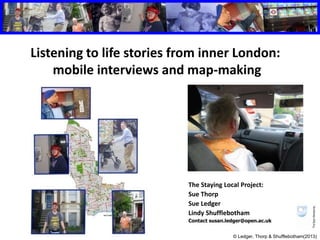Listening to life stories from inner London: mobile interviews and map-making
- 1. Listening to life stories from inner London: mobile interviews and map-making The Staying Local Project: Sue Thorp Sue Ledger Lindy Shufflebotham Contact susan.ledger@open.ac.uk ┬® Ledger, Thorp & Shufflebotham(2013)
- 2. Our time with you today ŌĆó Setting the scene : The Staying Local Project and what we wanted to find out ŌĆó Mobile interviews and map making ŌĆó Reflections ŌĆó Questions ┬® Ledger, Thorp & Shufflebotham(2013)
- 3. Why research local support? ŌĆó For a long time government policy has said that all people with learning disabilities should receive support in their local community (HM Govt 2007, ADSS/DH 2011) ŌĆó But large numbers of people continue to be moved away from their local area to receive a service ŌĆó People with high support needs are more likely to be moved (Becker 2006, DH 2007) ŌĆó Problem particularly bad in inner London (Whelton, 2009) where research took place ┬® Ledger, Thorp & Shufflebotham(2013)
- 4. Kensington and Chelsea - 2006 119 people with high support needs funded by the borough ┬® Ledger, Thorp & Shufflebotham(2013)
- 5. 25 were living in Kensington & Chelsea 94 living away ┬® Ledger, Thorp & Shufflebotham(2013)
- 6. Why it was vital to include people with high support needs? ŌĆó There are very few stories of local support told by people with learning disabilities themselves ŌĆó We wanted to find out if the stories of people who stayed local could help others to do the same ┬® Ledger, Thorp & Shufflebotham(2013)
- 7. How we did the research Nine people reconstructed and recorded their local life stories (including 5 people described as having high support needs) Interviews with 36 people involved in local support inc. families, front line staff, advocates, campaigners, managers Case records and archives Mobile Interviews and Map Making were developed during the research ┬® Ledger, Thorp & Shufflebotham(2013)
- 8. How Mobile interviews came about We found that walking or driving together in the areas where people had grown up made it much easier to share information about important people and places We called these mobile interviews. Altogether we did 14 mobile interviews ┬® Ledger, Thorp & Shufflebotham(2013)
- 9. SueŌĆÖs Film ┬® Ledger, Thorp & Shufflebotham(2013)
- 10. Driving, walking and taking photos My old front door ┬® Ledger, Thorp & Shufflebotham(2013)
- 11. How Life Journey maps came about: LennieŌĆÖs Story Lennie was one of the first people to record his story He had photographs of the house where he used to live with his family He wanted to show staff where he had lived Staff couldnŌĆÖt understand Lennie or recognise the streets in the photographs-they didnŌĆÖt live in the area. They did not know LennieŌĆÖs history To explain we put LennieŌĆÖs photos on a large A-Z Map Lennie could follow the photos -Staff were able to understand the locations The life journey maps were developed to help people keep and share their stories ┬® Ledger, Thorp & Shufflebotham(2013)
- 12. Making the life journey maps Some people chose family photographs to represent a part of their life story People also used photographs taken during mobile interviews Chosen images were then superimposed on maps People used multi media to select images for their individual maps ┬® Ledger, Thorp & Shufflebotham(2013)
- 13. ┬® Ledger, Thorp & Shufflebotham(2013)
- 14. Evaluation of the maps by people with learning disabilities ItŌĆÖs good to have everything in one place and in the right order The maps helped me talk about the moves IŌĆÖve had We have all lost parts of our past. ItŌĆÖs good to choose my own photos The map helped me to tell people about myself and my family ┬® Ledger, Thorp & Shufflebotham(2013)
- 15. Using the maps ┬® Ledger, Thorp & Shufflebotham(2013)
- 16. Reflections: what went well ŌĆó The maps and mobile interviews, supported people to own and share their life stories ŌĆó Ideas developed with people with high support needs benefitted everyone ŌĆó Openness to the development of new tools and ways of working ŌĆō seeing what works well different people ŌĆó Being flexible enough to change if original method doesnŌĆÖt work ŌĆó Remembering that everyone is an expert in terms of their own lived experience ┬® Ledger, Thorp & Shufflebotham(2013)
- 17. Barriers to Inclusion ŌĆó Access . ŌĆó Time pressure ŌĆó Fear of failure ŌĆó Worry about risk and harm ŌĆó Resources ŌĆó Researcher skills BUT EVERYONE HAS A STORY TO TELL... or as Robert said - ŌĆ£You guys story makes you who you are todayŌĆØ ┬® Ledger, Thorp & Shufflebotham(2013)
- 18. Thank you very much Questions


















